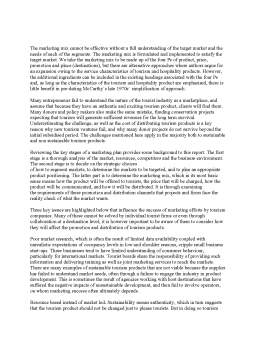Extras din proiect
Marketing is assuming an ever more impotant role given the lack of stability of world markets. The tourism market will never be the same again given the new realisation that terrorism, weather-induced catastrophes and health-related problems can affect generating countries and tourism demand behavior. The turn of this century has produced turbulence of an economic, social and increasingly political nature. In turn this has subsequently led to changes in the consumption patterns of travel around the world. Many international tourism companies and destination markets have experienced a softening of demand and reduction in average daily expenditure. The reasons include factors such created risk and excessive debt. In addition other events have compounded the problems of tourism companies whereby the risk of illness, such as SARS in humans or food and mouth in animals, natural disasters such as tsunamis, ongoing terrorist activity and subsequent conflict have occurred.
All tourism activity is changing from relaxed thrill and experience of the trip to some apprehension of what may be the downside risk. Given the need for steady demand, the role of marketing will become increasingly important for tourism organisations, operating in both public and privat sectors, as they continue to strive to product and improve their market share.
The process of marketing and its management provides companies and organisations with the many complex tools to affect demand in targets markets. It is a complex area that, as this section highlights, requires expertise and experience for success. In this section, we provide a comprehensive evaluation of all aspects of the management ot tourism marketing including the strategies to satisfy the tourism consumar.
The concept of marketing and its practical applications have evolved as a result of changing and social conditions that have emerged throughout the last century. The differences between sales and marketing were covered so that the reader will be more aware of why marketing planning and understanding the consumer is an important component of tourism marketing.
The tourism product is predominately a service product with the main characteristics of intangibility, perishability and inseparability. The tourism purchase involves complex decisions related to perceptions of risk and the expectation of high levels of quality. As such there is a need for a deeper understanding of the process af TQM an consumer`s expectation of service delivery standards.The use of marketing should take into account the issues surrounding the criticism of its application and as such understanding of consumerism, social responsibility and ethics is important.
Marketing planning is is probably the most important activity for any tourism organization. The long-term survival of an organization is related to the way that it understands how to assess its environment, set sensible objectives and choose logical strategies for achieving success. Utilization of different models such as SWOT, PESTEL, Porter`s five forcer model and the BCG model all allow for a more informed approach to the planning analysis. The conditions for maximizing the advantages from planning are based upon the need to understand the human aspects of the process as well as formalized procedures of a structured approach.
The marketing mix cannot be effective without a full understanding of the target market and the needs of each of the segments. The marketing mix is formulated and implemented to satisfy the target market. We take the marketing mix to be made up of the four Ps of product, price, promotion and place (destinations), but there are alternative approaches where authors argue for an expansion owing to the service characteristics of tourism and hospitality products. However, the additional ingredients can be included in the existing headings associated with the four Ps and, as long as the characteristics of the tourism and hospitality product are emphasised, there is little benefit in pre-dating McCarthy`s late 1970s` simplification of approach.
Many entrepreneurs fail to understand the nature of the tourist industry as a marketplace, and assume that because they have an authentic and exciting tourism product, clients will find them. Many donors and policy makers also make the same mistake, funding conservation projects expecting that tourism will generate sufficient revenues for the long term survival. Underestimating the challenge, as well as the cost of distributing tourism products is a key reason why new tourism ventures fail, and why many donor projects do not survive beyond the initial subsidised period. The challenges mentioned here apply in the majority both to sustainable and non sustainable tourism products.
Reviewing the key stages of a marketing plan provides some background to this report. The first stage is a thorough analysis of the market, resources, competitors and the business environment. The second stage is to decide on the strategic choices
of how to segment markets, to determine the markets to be targeted, and to plan an appropriate product positioning. The latter part is to determine the marketing mix, which in its most basic sense means how the product will be offered to tourists, the price that will be charged, how the product will be communicated, and how it will be distributed. It is through examining
the requirements of these promotion and distribution channels that projects and firms face the reality check of what the market wants.
Preview document
Conținut arhivă zip
- Turism si Industria Hoteliera.doc



















